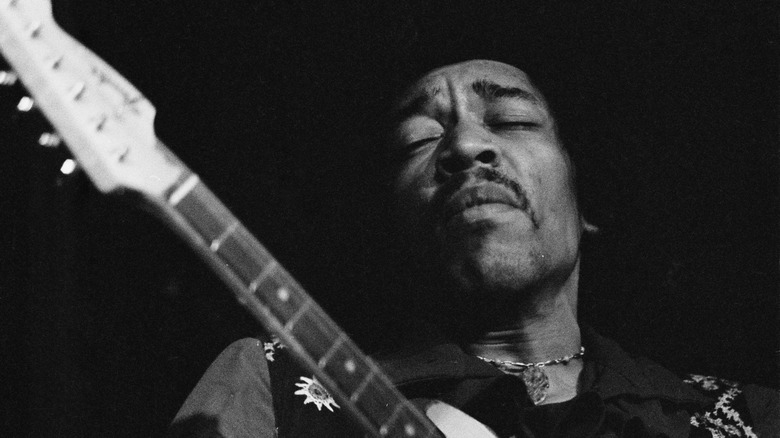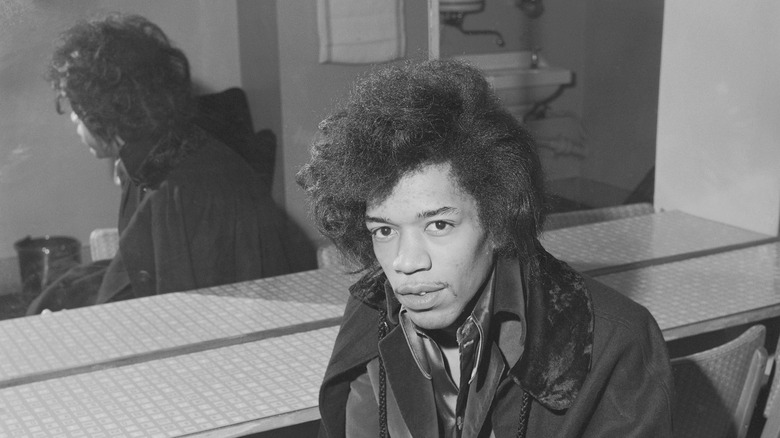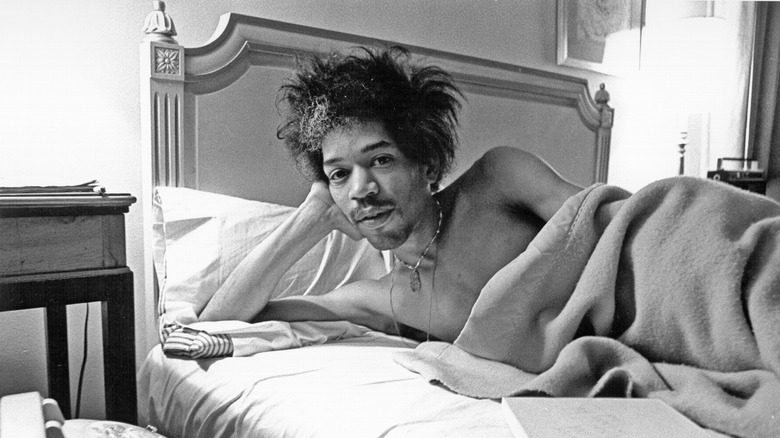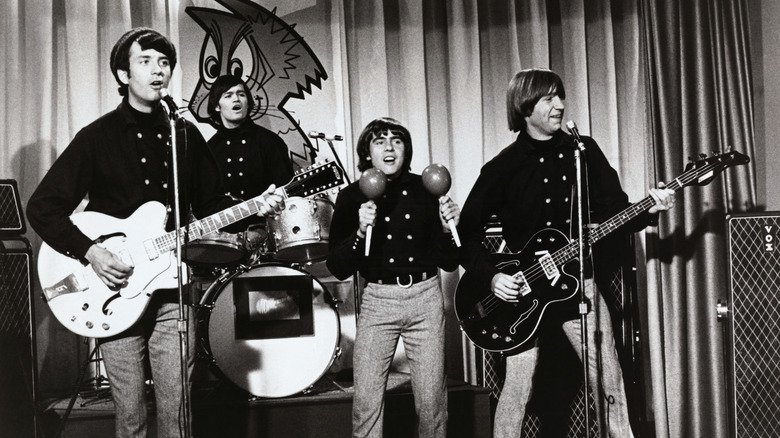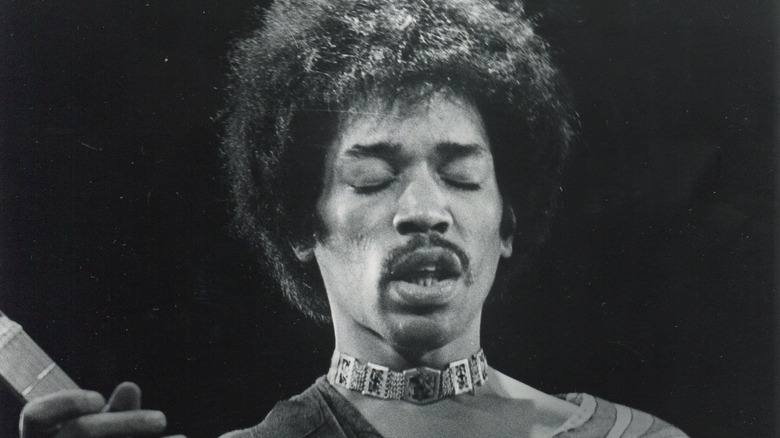Things We Learned About Jimi Hendrix After He Died
Twentieth-century rock stars enjoyed a mythic status that few celebrities today, in the age of social media, could possibly dream of. One of these musicians was Jimi Hendrix, the legendary rock and blues guitarist who pushed the boundaries of what the electrified version could do, and changed the sound of popular music in the process. His prowess and allure were so otherworldly that, for many of his fans, he was superhuman. "Hendrix was an alien, okay? His ship landed, they said, "Jimi, show 'em how it's done and we'll pick you up in twenty-eight years," quipped stand-up Bill Hicks (via Southwest Review).
Known also for his cool looks and his hard-partying lifestyle, Hendrix has nevertheless gone down in history as perhaps the greatest guitarist who ever lived. Though he was widely admired by his fellow musicians as well as rock music fans during his lifetime, Hendrix's legend no doubt skyrocketed after his tragic death at the age of 27 on September 18, 1970. In the years that followed, dozens of biographies were published that attempted to lift the lid on the real life of one of popular music's most iconic and mysterious performers. Here are a few facts we have learned along the way.
Hendrix had a traumatic early life
One person who has attempted to set the record straight concerning the life story of Jimi Hendrix is his father, Al, whose memoir, "My Son, Jimi," was published in 1999. In it, Al describes the early part of his relationship with Hendrix's mother, Lucille, and the difficulties that befell the family before and after the future rock star's birth. Hendrix was born on November 27, 1942, less than a year after the United States entered World War II. As a result, Al had been drafted and was away from home for much of Hendrix's early life.
Left to her own devices, Lucille, who was still a teenager, struggled to care for her young son. Working in bars as a waitress and occasional singer, she began drinking heavily. Al returned from the war and he and Lucille continued a tumultuous relationship. The couple continued to have children, but a few of Hendrix's siblings spent time in foster care, per The Seattle Times. Lucille and Al divorced when Hendrix was around 9 years old, after which he lived with his father. Lucille developed cirrhosis of the liver and died in 1958 of a ruptured spleen at the age of 32 when Hendrix was 16.
More disturbingly, Hendrix's childhood was also abusive. According to a former girlfriend, Hendrix once told her that he had been molested by an unknown man as a child, a trauma that he carried with him into adulthood, according to "Room Full of Mirrors : a Biography of Jimi Hendrix."
He reportedly fathered 2 children
It's no secret that rock stars are often lotharios, and Jimi Hendrix was no exception. In the years since his death, it has become clear that the guitarist had many women in his life, and often had several girlfriends at the same time. Little did anyone outside his immediate circle know at the time, Hendrix had also fathered two children during his years of wild living. According to a 1972 Rolling Stone article, the first, a daughter named Tamika, was born February 11th, 1967, to Hendrix's ex-girlfriend Diane Carpenter, who lived with the guitarist in both Los Angeles and New York in 1966. It was later reported that Carpenter had attempted to secure a paternity test in the months prior to Hendrix's death. She later filed a lawsuit to claim a portion of the Hendrix estate, though a judge ruled that it should go entirely to Hendrix's father, Al.
It was later revealed that Hendrix had another child, a son named James Henrik Daniel Sundquist, the result of a hook-up while on tour in Sweden in 1969. Sundquist was declared Hendrix's legal offspring in 1975 by a Swedish court even though no biological paternity was never proven, and in 1995 Rolling Stone reported that Sundquist, who also went by Jimi Hendrix Jr., had taken unsuccessful steps to establish himself as an heir of his father's estate.
The real reason he left the 1967 Monkees tour
Today, Jimi Hendrix is considered one of the defining figures of the 1960s counterculture. But the truth is that even as late as 1967 he was struggling to achieve the public profile he and his management team knew he deserved. As such, he wound up signing on to be the opening act for one of the biggest up-and-coming bands in America: The Monkees.
The group had burst into the popular consciousness thanks to their self-titled TV show, "The Monkees," which had become an instant smash after first airing on NBC in 1966. However, they were also controversial, especially among hardcore rock fans. The band had been manufactured for the show, and though its members would later establish themselves as songwriters and performers of note, when they first broke through they were given songs by a writing team. The combination of the Monkees and Hendrix on the same bill was uneven, to say the least. By then, Hendrix was known for his erotic and provocative performances, which involved simulating sex with his guitar and destroying equipment, while the Monkees presented themselves as a family-friendly act, with children making up a large portion of their fanbase.
It was initially reported that Hendrix had been fired from the tour after complaints from the conservative campaign group "Daughters of the American Revolution." However, according to the book "Eyewitness: Jimi Hendrix," this was a rumor manufactured by Hendrix's PR team, as he grew to loathe touring with the Monkees and quit after seven shows.
Hendrix's brutal schedule left him exhausted
Jimi Hendrix's energetic and frenetic live shows made him a symbol of youthful vigor and vitality, with few of his fans ever suspecting that he was to lose his life at the age of 27. However, behind the scenes the rocker was slowly beginning to unravel, with the demands upon him, gradually taking a toll on both his physical and mental health.
As well as an extensive touring schedule, he was involved in movies, traveling to Hawaii to film the movie "Rainbow Bridge," and he had become a habitual user of hard drugs, which meant his performances were becoming increasingly erratic. At the same time, his management required him to find the time to write and record new songs for his fourth studio album, as well as book a fresh list of concerts to continue to build his fanbase.
It was under such stress, as well as legal issues including the paternity suit, which reportedly left Hendrix depressed and unable to sleep. In response, he leaned even harder on alcohol and drugs, including the sleeping tablets which were directly responsible for his death.
He had grown prolific again before his death
However, despite the demands of Jimi Hendrix's professional and personal lives both affecting him in his final years, the innovative songwriter and recording artist was arguably back on track when it came to his creativity. For several years, Hendrix's recording career had gone through a comparative dry spell. The three studio albums he recorded with his band The Jimi Hendrix Experience had all been released in a flurry of activity in 1967 and 1968, and the trio had split the following year, leaving Hendrix to develop a new stage act and establish a new band that could match his musical ambitions.
That group, Band of Gypsys, toured with Hendrix toward the end of his life, and together released a self-titled live album in 1970, featuring several new compositions, such as the fan favorite "Machine Gun," which had never received a studio release. After Hendrix's death, "Band of Gypsys" became a touchstone for his fans and a glimpse into where his career might have headed.
But in the year that followed, Hendrix's management — working fast to capitalize on the musician's death and their existing contracts with him — sought to gather as much studio material as possible and to release the best of it to the public. The results were two critically divisive albums: "Rainbow Bridge," ostensibly a soundtrack to the film of the same name, and "The Cry of Love," both released in 1971.
